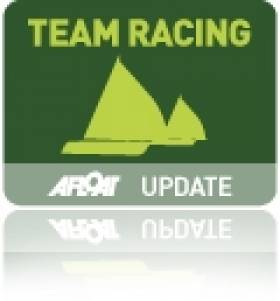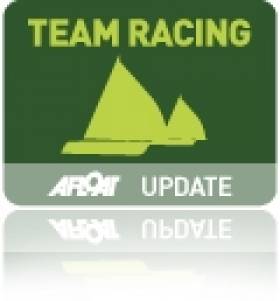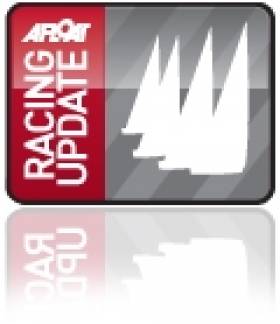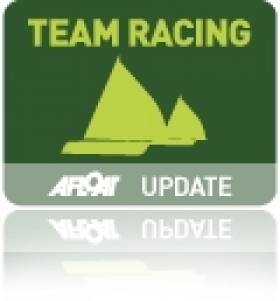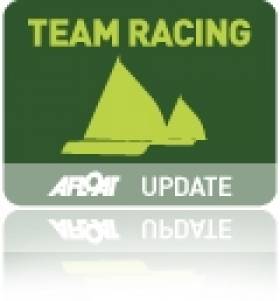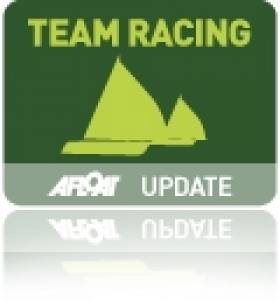Displaying items by tag: Team Racing
#TEAM RACING – The Royal St. George Yacht Club Team Racing Invitational was once Ireland's most prestigious team racing event. After a lapse of a few years, the club hosted a revived "George Invitational" on Saturday March 10th. One tradition remained unchanged, as the event was sailed in Firefly dinghies.
The seven teams could not have asked for more perfect conditions as the current elite of Irish team racing gathered for one day of intense sport. Competing teams included the Royal St. George, Howth Yacht Club, UL, UCC, UCD, TCD and a last minute wonder team, LGN. With a perfect 10 to 15 knot breeze blowing across Dun Laoghaire harbour from the East Wall and relatively clear skies the stage was set for a fantastic event.
The day saw the first use a new course aptly named the Starboard Boot. This provided 6 marks, instead of the usual 4, for teams to set traps and confound both their opponents and the umpires.
After an intial round robin, in which all teams sailed each other once, the fleet was split. The top 3 teams went up into a Gold Fleet and the bottom 4 went into a Silver Fleet. Both the Royal St. George and Howth Yacht Club teams easily topped the group but a re-sail of a race between UL and LGN was required to settle the 3rd place . UL won this race.
The Gold Fleet then raced each other twice in another round robin while the Silver Fleet raced each other once. The winner of the Silver fleet was then promoted to Gold, and the last Gold team was relegated for a further, deciding, round.
The Gold Fleet provided an exciting and technical display of team racing. Howth Yacht Club managed to narrowly beat both UL and the Royal St. George in the first half of the round robin. UL then lost to the Royal St George in a highly contested race with flags and umpire decisions flying left, right and centre! In the second half of the round robin a surprise upset saw UL defeating both the Royal St George and Howth Yacht Club and Royal St George losing once again to Howth Yacht Club. The Royal St. George, the favourites of the event were relegated to the Silver Fleet for the final round, with LGN promoted to Gold.
Howth Yacht Club put paid to any aspirations by the other two teams and soundly defeated both UL and LGN both times they met each team in the final round. With UL defeating LGN twice in the same round the results were:
Howth Yacht Club in 1st,
UL 2nd
LGN 3rd.
Royal St George easily topped Silver to take 4th
UCC 5th
UCD 6th
TCD 7th.
In conclusion, all competitors agreed it was probably the highest standard of team racing seen this season on. The event organiser, John Sheehy, the Royal St George Yacht Club, the umpires and volunteers are to be congratulated.
Next year the event will return to the traditional two-day format, with team racers scrubbing up on Saturday evening for dinner in the RstGYC dining room.
Lastly, good luck to Howth Yacht Club and Royal St. George who are heading to the Wilson Trophy in West Kirby in May. If the display of team racing just gone is anything to go by Ireland will be well represented at Europe's foremost team racing event. Incidentally, three of the umpires officiating in the "George Invitational" will also be travelling to West Kirby for the "Wilson".
Team racing continues in Dun Laoghaire with the Leinster Schools on 24th March and the Varsity Colours event on 31st. The Irish Team Racing Nationals will be sailed in Schull on 10th-11th November.
For more information regarding team racing contact: [email protected]
'2k' Format Will be New Lease of Life for Team Racing
Irish team racers, and those whose college sailing days are behind them, can look forward to rediscovering the joys of a new kind of team racing writes our Correspondent, Magheramore.
The Dutch have discovered team racing. They have become very keen on two boat team racing in keel-boats with 30 teams competing in their National Championships. Realising the potential for this version of the sport a major international event is planned in September this year, and there is a bid to run an official World Championships in 2013.
An international circuit is now emerging for this discipline – now known as 2k. Events are planned on the Clyde, in Italy, Poland, England and the Netherlands. The potential is considerable. In many countries sailing centres have fleets of small one design keel-boats already used for match racing. 2K racing increases the number of days these fleets are in competitive use. There is also a well established circuit in the USA, where the Sonar is commonly used. There are even events organised especially for the more mature sailor.
This should be good news for Irish sailors. We have a long tradition of team racing, with predominately university teams competing in Firefly dinghies. In Munster, the group based around Schull Community College has provided a base for schools team racing, and the whole town did a magnificent job of hosting the Worlds last year. In addition, the Royal Alfred Yacht Club has maintained a tradition of team racing in keelboats with the Patriots Cup, not to forget the Glen class in Dun Laoghaire who compete in the Millennium Cup, a 4 boat per team event. Many graduate sailors have moved on to match racing, using the Sailfleet J80s, with some success.
The development of 2k racing is an opportunity for clubs. Team-racing, in all its forms, creates a dynamic within the club, as teams train and compete and socialise. Graduates, who seem to find the Firefly gets smaller every year, can relive the exploits of their college days without breaking the bank. As events can be graded, adult trainees can experience the joys of competitive sailing at level suited to their ability. Sailing club boats will increasing look an attractive proposition to the negative-equity generation
The initial outlay to procure a fleet of boats may seem a considerable obstacle. However, if the right boat is chosen they can have a long and useful life. There is, for instance, in Brittany, a fleet of Beneteau Class 8s that have been raced hard for 20 years and are still in use for top class competition. The Dun Laoghaire 1720s also demonstrate that there is no need to buy new boats.
The cost of a day's sailing, including maintenance and depreciation, reduces rapidly the more boats are used. If a fleet can be used for match racing, 2k racing and adult training then the number of days sailed should sufficient to cover these costs.
With moves afoot to further develop junior and schools team racing this most social version of the sport is a true "Sport for Life" with the added advantage for sailors (and their parents!) of being able to compete at the highest level without the strain of owning a boat. It is now possible to envisage a career in sailing progressing from beginners sailing courses through junior team racing in Picos, then Fireflies or similar, with the prospect of travel to the UK, the USA or the Eurosaf Championships on the lagoon in Venice. After college racing and a foray in to the UK circuit (and further afield) a move to keel-boats would allow sailors to continue to race almost indefinitely.
All in all, the Dutch initiative to develop team racing in keelboats is to be welcomed. Irish team racers, and especially those whose college days are behind them, can look forward to rediscovering the joys of the squeeze, the mark trap and the sweet sound of the umpire's whistle! Anyone for a trip to the Low Country...?
Racing update: DBSC, ISORA, Royal St. George Knights, Olympic Keelboat Drama and Kinsale's Club House
Abroad, Keelboats are out of the Olympic Games (and kitesurfing is in!). Royal St. George Knights were quarter finalists at the British Team Racing Champs. There is video too with Irish commentator Jimmy Fitzpatrick.
Should Kinsale Yacht Club move or rebuild a crumbling premises?
Overall Winners Beat Royal St. George YC in Quarter Finals of Team Racing Championships
RSGYC Knights won their final round match against Spinnaker with a last ditch attack on the approach to the finish line, to move them on to 12 wins and give them a place in the knock out rounds. Despite a loss to West Kirby Hawks, Buns & Ammo's 12 wins total also assured them of a place in the next round. Woonsocket Rockets defeated Southampton to move to 11 wins and give themselves a realistic chance of getting into the final eight. NYYC Team Extreme won out over West Kirby SC to leave the host club team hoping that 12 wins would be enough to keep their hopes alive. Southampton Male Voice Choir, needing to win their match against Dream Team to have any chance of staying in the competition, took the fight to their opponents right from the start, and after a dust up of a match, Southampton finally managed to get themselves into a winning position on the final beat. This result put both teams on 11 wins and still in with a shout of a quarter final place.
At the end of the 20 round, 320 race, Swiss League competition, West Kirby Hawks (17 wins), BUSA Lads (14), NYYC Team Extreme (14), Spinnaker (13), Buns & Ammo (12), RSGYC Knights (12) West Kirby SC (12), were all confirmed as quarter finalists. Giving some indication of the closeness of the racing in this year's Wilson Trophy, there were then no less six teams tied on 11 wins, left to await the outcome of the scorer's mathematics to determine whether they had earned a place in the quarter finals. Ultimately, the count back calculations went in favour of Oxford & Cambridge, meaning that their 11 wins were good enough to give them the one remaining quarter final place.
Conditions were absolutely perfect for the quarter finals, with sunshine and 10 - 12 knots of breeze. In the first flight, West Kirby Hawks made quick work of Oxford & Cambridge, dismissing them 2 - 0, to secure the first of the semi final places. NYYC Team Extreme also overpowered Royal St. George YC Knights by two wins to zero to take the second semi final place. The quarter final match between Spinnaker and Buns & Ammo went to Spinnaker by two races to nil. Having won a race apiece, West Kirby SC and BUSA Lads, needed a final deciding race to establish who would take the last semi final place. After a closely fought race, West Kirby SC got themselves into a winning position on the final beat to close out the race and claim the last semi final slot.
The semi final pairings pitched West Kirby Hawks against Spinnaker and NYYC Team Extreme against West Kirby SC. With a place in the final at stake, all four teams knew they needed to be at the absolute top of their game, and from the very first race the hordes of spectators now lining the shoreline and packing the grandstand were treated to a simply breathtaking display of the highest quality team racing. In the match between West Kirby Hawks and Team Extreme, the Hawks took first blood after a full on fist fight of race. In the second heat West Kirby Hawks took control on the penultimate leg with a 1,2 combination, but a umpire penalty for their second placed boat then threw the advantage back to Spinnaker, who took the win with a 2,3,4, to even the match. The final race was another classic with West Kirby Hawks eventually prevailing to win with a 1,4,5 combo. A redress request for gear failure on one of the Spinnaker boats in the first race resulted in that race being re-sailed, but the result remained unchanged when the Hawks clocked up another win.
The match between West Kirby Hawks and NYYC Team Extreme was similarly thrilling, with the host club narrowly taking the first race. NYYC Team Extreme struck back in the second race, rounding the final mark holding first and second, a position they were comfortably able to maintain to the finish. The deciding race of this match hung in the balance until the final beat, when the NYYC Team Extreme turned on the team racing style, to take the win and set up a repeat of last year's Grand Final against West Kirby Hawks.
By the time the Grand Final got underway the wind had risen considerably again and with the boats still on full rigs, the crews had some real boat handling challenges to deal with. As expected, the Grand Final was a spectacular affair, with the two teams putting on a full bore team racing masterclass, much to the appreciation of the hundreds of delighted spectators, who loudly cheered every maneuver. The first race went to NYYC Team Extreme after West Kirby Hawks squandered a potentially winning position on the final beat. Quickly regrouping, the Hawks struck back in the wild and windy second race, to level the score. NYYC Team Extreme then took the next race to establish a 2 - 1 advantage. With the wind now topping twenty knots in the gusts, the race committee in the interests of fair team racing, made the sensible decision to send the teams ashore to change to the smaller rigs. Given the extreme conditions, the pre-start action in the third race was surprisingly intense, with the two teams hurling themselves at each other like a couple of street gangs in a turf war. However, from the moment the start gun sounded, the Hawks knew they were in trouble - with two boats over early and forced to restart. NYYC Team Extreme are simply too good a squad to hand such an advantage to, and given control so early in the race they rocketed away to close out the Grand Final with a comprehensive win.
Official Overall Results:
Quarter Finals
West Kirby Hawks beat Oxford and Cambridge
West Kirby beat BUSA Lads
NYYC Team Extreme beat RSGYC Knights
Spinnaker beat Buns & Ammo
Semi Finals
West Kirby Hawks beat Spinnaker
NYYC Team Extreme beat West Kirby
Grand Final
Team Extreme beat West Kirby Hawks (3-1)
NYYC Team Extreme (USA):
Zach Brown and Emmet Smith
Thomas Barrows and Marla Menninger
Stuart McNay and Michael Hession
West Kirby Hawks (UK):
Ben Field and Tom Foster
Dom Johnson and Debs Steele
Andy Cornah and Hamish Walker
Day Two Update: The relentless pace of the racing schedule at the 2011 Wilson Trophy for the British Open Team Racing Championship continued on the second day, with the first races of the day getting underway shortly after 8AM. Despite the earliness of the hour, the ferocity of the team racing action was undiminished, with the cool morning air echoing to the sound of competitors shouts and umpire's whistles. With the breeze steadily increasing from 10 knots for the early races up to just short of 20 knots by around 11 o'clock, the call was sensibly made to make the change down to smaller sails.
Overnight leaders, Oxford & Cambridge, the only team to make it through yesterday undefeated, started the second day with a comfortable win over Woonsocket Rockets, but then went on a four race losing streak, falling in quick succession to Dream Team, BUSA Lads, Southampton Male Voice Choir and Buns & Ammo. In contrast West Kirby Hawks put on an impressive display to defeat Wessex Exempt, NYYC Team Extreme, Spinnaker, BUSA Lads and Woonsocket Rockets - leaving them top of the table at midday.
Early in the afternoon though West Kirby Hawks suffered a defeat by Spinnaker after a very tightly fought match. This win for Spinnaker was their third of the day, and further wins against Dream Team, Southampton Male Voice Choir, and Oxford & Cambridge moved them up to second overall with 8 wins after 11 rounds. Also on 8 wins were BUSA Lads and Buns & Ammo, with Oxford & Cambridge, NYYC Team Extreme, Southampton Male Voice Choir and Royal St. George Knights, all on 7 wins, rounding out the top eight at that point.
The battle for the top eight continued to rage throughout the rest of the afternoon with West Kirby Hawks continuing to hold a slender one win advantage over the rest. Behind them the rankings were so tight that as the afternoon wore on the matches became more and more frenetic. By late afternoon however, the standings were becoming a little clearer. The Hawks were still on top with 12 wins, ahead of second placed Buns & Ammo who had strung together a series of well timed wins (including a defeat of the Hawks) to take them to 11 victories in total. BUSA Lads and NYYC Team Extreme both shared 10 wins with Spinnaker and Wessex Exempt also tied on 9 wins. In the fifteenth round of the event, a win for the Hawks over Southampton moved them on to 13, but soon after a key match against NYYC Team Extreme saw the American team eke out a narrow 2,3,4 win, to bring their tally up to 11 wins and move them up to second overall.
When racing ended with the completion of Round 16, the Hawks had moved on to 13 wins and second placed NYYC Team Extreme had also advanced to 12 wins. Buns & Ammo, BUSA Lads, and Spinnaker finished the second day on 11 wins, ahead of Southampton Male Voice Choir on 10 wins. Oxford & Cambridge and Dream Team, completed the top eight, each with 9 wins.
With only a few more rounds now likely before the final day's lunchtime cut off, the clutch of teams all tied on 9 wins, Woonsocket Rockets, Ungrateful Colonists, RSGYC Knights, Wessex Exempt, Southampton 1, West Kirby SC and Super Troupers, will know that they need to outperform in the morning to secure a place in the elimination rounds.
Racing at the 2011 Wilson Trophy for the British Open Team Racing Championship comes to a conclusion on Sunday 8th May, with a morning of Swiss League followed by the elimination rounds culminating in a Grand Final between the top two teams.
Racing got underway on time and in perfect conditions on the first day of the British Team Racing Championship at West Kirby Sailing Club, where 32 teams from across the UK, Ireland and the USA have congregated on the marine lake for three day's of high intensity team racing action. With all the top teams who have qualified for the upcoming Team Racing World Championship in Ireland competing here this weekend, this year's Wilson Trophy is set to be one of the most competitive in the event's sixty-two year history.
There can be few better venues than West Kirby to run a team racing event of this scale. The marine lake has 360 degree access allowing spectators unlimited vantage points from which to observe the action. Racing takes place in a fleet of thirty-six equally matched and colour-coded Firefly dinghies provided by the organisers. A twenty-five strong armada of international umpires are on hand to oversee the racing and administer instant justice in the form of on the water penalties. Over 350 races will be completed before the elimination system narrows the field down to just the top two teams the Grand Final, to be sailed in front of a packed and noisy grandstand on Sunday afternoon.
Midway through the afternoon, with four rounds completed only three teams, West Kirby Hawks, Oxford & Cambridge and Dream Team unbeaten with a 4 - 0 scoreline. With just one loss each was NYYC Team Extreme, Woonsocket Rockets, Buns & Ammo, and Wessex Exempt. Early in the fifth round West Kirby Hawks matched up against Dream Team, with the Hawks immediately taking control of the race before consolidating their advantage to take a 1,2,3, win. Oxford & Cambridge also dismissed NYYC Team Extreme with a 1,2,6 combination, leaving just the Hawks and Oxford & Cambridge unbeaten at that point.
The sixth and final round of the day saw a pitched battle of a race between the Hawks and Oxford & Cambridge for first day bragging rights. The teams were locked together for the entire race, with control switching back and forth on every leg. Even as the two teams approached the finish line, the match was still undecided, with the last few maneuvers of the leg seeing Oxford & Cambridge pull off a 1,3,6 combo to take the win.
So with six rounds sailed on the first day the standings are as follows:
1st Oxford & Cambridge - 6 wins
2nd West Kirby Hawks - 5 wins
3rd Woonsocket Rockets - 5 wins
4th Dream Team - 4 wins
5th NYYC Team Extreme - 4 wins
Racing at the 2011 Wilson Trophy for the British Team Racing Championship at West Kirby Sailing Club continues tomorrow with more Swiss League Rounds.
Full results at the regatta website here
Irish Teams Selected for Team Racing World Championships
After the first round the home team, the "George Gladiators" were demonstrably the leading senior team. They won all their races, and in all but one race finished in first and second place. The "Supertroopers", mainly University of Limerick graduates, were second with 5 wins and UCD1 4 wins. These 3 teams proceded to the second round, sailing each other once. In order to qualify UCD1 needed to beat both other teams. Unfortunately, they lost their first race to the "Gladiators". The "Gladiators" then relaxed, loosing their only race of the day to the Supertroopers, who then beat UCD1.
In the Youth event, Schull1 won 3 races, Schull2 2 races. This was enough to ensure selection.
As a result of these trials the Irish Team Racing Association will be recommending the following teams to represent Ireland (subject to meeting all eligibility requirements) at the ISAF World Team Racing Championships, to be sailed in Schull,West Cork in August:
Ireland 1
Marty O'Leary, Brian Fenlon, Sam Hunt, Jodie-Jane Tingle, Andrew Fowler, Rachel Guy
Ireland 2
Darragh O'Connor, Hannah Herlihy, Kevin Stollard, Rachel O'Brien, George Kingston, Tom Martin
Ireland Youth 1
Connor Miller, Ellen O' Regan, Oisin O'Driscoll, Katie Moynihan, Jay Jay Stacy, Kaspar Snashall
Ireland Youth 2
Fionn Lyden, Tomas O'Sullivan, Darragjh McCormack, Mark Hasset, Pearse O'Flynn, Gleb Romantchik
Preparations Underway for Team Racing Worlds
With the advent of 2011, preparations are now well under way for the holding of the ISAF World Team Racing Championships at Schull from August 27th, 2011 to September 23rd, 2011 writes Claire Bateman. It is a major triumph for the village of Schull, Co. Cork to host the World Championships. The organising committee on behalf of the Fastnet Marine and Outdoor Education Centre (FMOEC) was set up in 1997 and is an adjunct of Schull Community College and the facilities function under the auspices of the Cork County Educational Committee. As Schull is a village community this event will be seen as a community undertaking and the Schull Development Association will be a co-operating organising authority.
The event will be sailed in TR3.6 dinghies which are not too dissimilar to a firefly and 26 boats will be built locally at a cost of €5000.00 each. The hulls will be manufactured in Midleton and the sails will be built by the local sailmaker, Fastnet Sails, in West Cork. So far twelve boats have been sponsored. One of these has been sponsored by Schull Harbour Sailing Club where members have come up with a novel idea to sponsor a second boat. This is a one hundred club where members and their friends each contribute €50.00 towards the project.
Team Racing is a very popular branch of sailing where everything happens very quickly and there is no better school for tactical decision making and understanding of the rules with six boats at a time performing an intricate and aggressive dance where two teams of three race to try and achieve a winning combination of places – with the lowest score winning.
ISAF wish to invite 28 teams to participate at the event in August with teams coning from as far away as Australia, New Zealand and the U.S. with the host country having three teams. Teams are also expected from Italy, Japan, Poland, the U.K. France and Croatia.
Further information or queries regarding sponsorship for this exciting World Championship can obtained from Mr. Tim O'Connor, Principal, Schull Community College at [email protected] or Mr. David Harte, Manager, FMOEC at [email protected].
Schull is a unique part of Ireland for sailing and socialising. The scenery is breath taking, the sailing waters are magnificent, the reputation for organisation of major events is second to none and all our good wishes for the successful running of this major undertaking are with the organisers.
Selection Procedure for Team Racing Worlds Underway
The selection procedure to designate the teams to represent Ireland at the ISAF Team Racing Worlds is underway.
Teams wishing to be considered for selection should contact the Irish Team Racing Association a [email protected]. A selection committee will then invite teams to trials to be sailed early in 2011. Invitations will be issued on the basis of the results of all team members (helm and crew) in 2009 -2010.
The trials will consist of a multiple round robin event. The Youth trials will be sailed in Crosshaven, and the senior trials in Dun Laoghaire. Unfortunately, the number of places available for Ireland at the World Championships is not yet known, but ITRA will select two senior teams, plus a reserve team, and two Youth teams, plus a reserve.
Spinnaker on Top in Team Racing National Championships
Last weekend's The Irish Team Racing Association National Team Racing Championships attracted it's largest entry for many years, with 21 teams registered.
The event was hosted by the Fastnet Marine and Outdoor Education Centre in Schull, West Cork.
Four teams travelled over from the UK, and 6 under 19 teams, all from County Cork, competed. They joined the keenest of the post-college teams and the leading university teams to constitute the largest Championships that Ireland has seen for many years. Schull, the venue for next year's World Championship, was a major attraction, but the change of date, from March to November, has made it easier for college students and school pupils to attend.

Weekend Team Racing action from Schull. More photos HERE. Photos: Brian Carlin
The weather forecasts had been predicting storms, floods and general mayhem for days if not weeks beforehand. But Saturday dawned to reveal Schull Harbour in an unusual state – the wind had disappeared! Racing started 3 hours later than planned. However, by the end of the day the first round had been completed. This was a seeded round robin, with each of the four League made up of a UK team, a leading Irish team, a leading college team and two others, including the youth teams.
The results of the first round determined entry into the second round – all the UK teams won all four leagues, with the George Knights, the George Gladiators, Supertroopers and UCD finishing second. These teams were joined in the Gold Leagues of the second round by the winners of play-offs between third place teams. The Bumsby Babes, a youth team from Royal Cork YC, had done well to win 2 races to qualify for a play-off against University of Limerick and they were in a strong position when equipment failure meant that one of their boats retired . In the subsequent re-sail UL managed to win the race and qualify.
On Sunday morning Schull was looking it's best in bright but cold sunshine. Unfortunately, the beauties of the West Cork landscape were exactly mirrored in the unruffled water of the harbour! Competitors, who had made a remarkable effort to arrive on time for an 0900 start, barely recovered from the reception organised the previous evening by the World Championship Committee, waited. When racing eventually got underway, in a fitful breeze, it quickly became obvious that there was no possibility of finishing the second round. Plan B was implemented, a knockout round between the four winners of Round One to determine the outright winner, another between the 4 Irish team placed second in the Round One Leagues to determine the ISA medal places and a Youth round.
GP14 World Champion Ian Dobson in Schull
Spinnaker came through the semis and final to win overall first place. The two Royal St George teams qualified for the final. Last year's winners, the Gladiators won the first race only after finishing places were confirmed by a redress hearing. However, the more experienced Knights went on to win the next to races to reclaim the trophy they had "lent" to the Gladiators last year. The third place play-off, which saw some of the noisiest races of the weekend, resulted in a win by Supertroopers over UCD.
In the Youth event Schull A beat Schull B to win the opportunity to take on, and eventually defeat the Bumsby Babes.
Next year's Championship will be sailed out of the Royal St. George on 12-13 November. However the next challenge for Irish team racers will be qualification for the World Championship, with selection trials planned for both the Youth and Open categories early in 2011.
The event was also the first opportunity to try the new TR3.6 which will be used for the Team Racing Worlds. Video below of the new TR3.6 and voice over from Team Racing World organiser David Harte in Schull. Stills by Brian Carlin HERE.


























